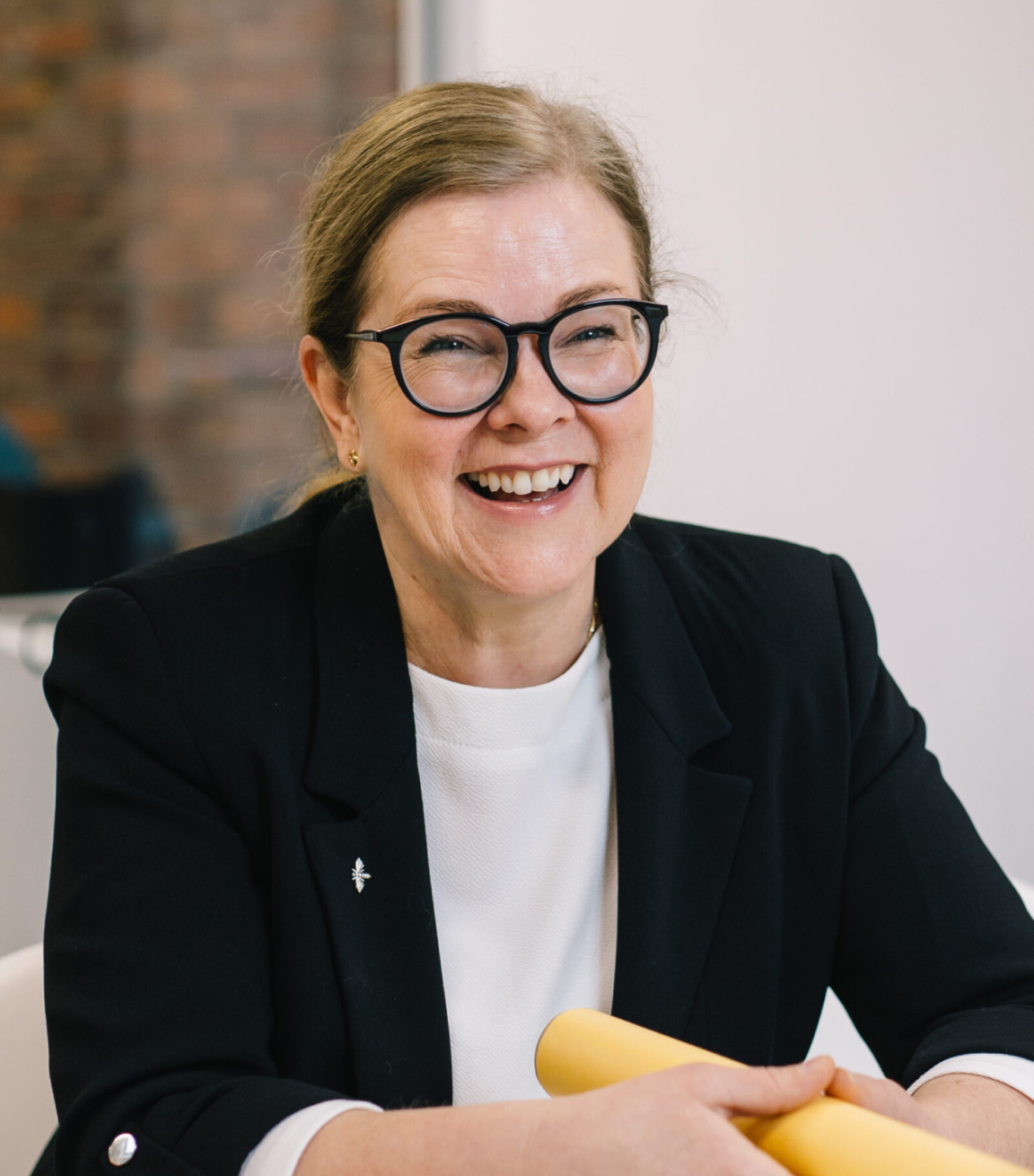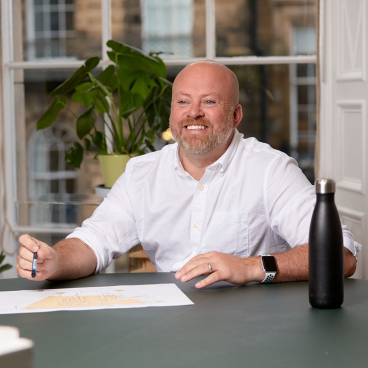Kim Ebling, director of decarbonisation, Corstorphine & Wright on the benefits of AI, social housing challenges & realistic renewables.

In her 25-year career, Kim Ebling has seen a lot of change. Some good. Some less so.
One thing that's prevailed, though, is a fervent dedication to embracing new tools. And underpinning this, an unwavering positivity. All in a bid to find better solutions for clients, and, ultimately, the planet.
When Kim joined us for our recent roundtable considering Manchester's residential mix, one of her comments particularly stood out. On the topic of AI, Kim said, "It’s a new toy and it’s exciting" - taking a very positive stance on what is generally a contentious topic in the architecture, design and property sectors.
Keen to continue this conversation with Kim, to find out more about how she's utilising AI and other tech-based tools to aid her role as director of decarbonisation at Corstorphine & Wright - especially in terms of public sector projects, social housing being her core focus - we invited her to take part in an interview. And, much to our delight, she agreed.
Here, we discuss Fabric First and Passivhaus approaches, what the consensus is on the Government's residential targets, and how cities in the North West are faring (Kim began her career at Urban Splash in Liverpool in the 1990s).
Plus, Kim shares with us her view on AI, and highlights some of the challenges currently faced in the industry - albeit always delivered with her signature forward-facing attitude.
Firstly, Kim, can you please give us a snapshot of your career to-date?
“My career has always been in architecture, albeit various guises from working for developers, architectural practices and so forth. I never planned on being an architect, in fact my studies were in psychiatry and linguistics, but after a few years of working abroad I came to England for work experience and landed a summer placement at an architectural practice.
“Following my placement, my then boss encouraged me to study architecture at university and I remember one of the first things that appealed to me about the industry was the variety of people you work with. In other industries you typically work with the same cohort of people, however in architecture you are speaking to different people every day. Whether that’s clients, contractors, suppliers, manufacturers, members of your multidisciplinary team, you’re exposed to a huge field of very different people, and I really enjoy the variety.
“Post graduation and qualification I started my architecture journey in a broad spectrum of sectors and became increasingly interested in the residential sector. I started in the private sector, where I worked on a number of high-end designs including the refurbishment of listed Mills to create new homes, offices, retail and leisure spaces.
“As time went on, I wanted to make places that better benefitted society and that’s how the move to social housing came about. As well as doing what I do now, making buildings future proof, I have always felt passionate about creating spaces that are more than just buildings; they are a place to call home.
“I want to ensure that all projects, whether for social or commercial purposes, contribute positively to the physical, mental, and social well-being of their users. The last 10 years of my career have been in social housing, and I think Corstorphine & Wright are on a great adventure in this space.”
You’re now director of decarbonisation at Corstorphine & Wright – what does your role entail?
“In addition to providing very robust, future-proof elements to a build (whether it’s new or existing, so Passivhaus or retrofit), which has been my career to-date, we are now able to look at renewables. Decarbonisation focuses on moving away from fossil fuels, so we are not reliant on further exploitation of the Earth’s natural resources and the idea is to be far more friendly for the future through our designs.
“It’s an incredibly exciting, national role with an extremely important message to be spread. At the moment, decarbonisation is a choice in architecture, however being brutally honest, if we continue as we have in the 80s, we are going to face some serious global climate changes. We continue to hear this doom and gloom through various conferences, the Paris convention for example, and whilst there are very detailed, stringent plans in place, plans are often failing due to commercial realities.
“From a client perspective, there is a beautiful philosophy by Henry David Thoreau that says, “What's the use of a fine house if you haven't got a tolerable planet to put it on.” - this is why decarbonisation is so important. We need to drive away from further exploiting the resources that are already limited, and we now have the knowledge and technology to do so without sacrificing comfort, quality or wellbeing.
"In fact, by considering decarbonisation initiatives you can actually improve this through design by dealing with less pollutants. Forward thinking clients embrace this change and funders, green funders definitely, now require this.
The more you understand decarbonisation, the more you can implement it and it’s important to recognise that decarbonisation doesn’t equate to a higher cost, it means clever application at early stages.
“At Corstorphine and Wright, we apply decarbonisation initiatives that suit our clients’ individual requirements and aspirations. By understanding what our clients are trying to achieve, we can offer solutions that genuinely make a difference.”
At our recent roundtable, you mentioned working on projects in Liverpool – how has the city evolved?
“Liverpool reminds me of my early Urban Splash days (particularly Concert Square!). The city has evolved in a very positive fashion. Commercially speaking, it’s a very desirable place to buy and rent, and it has a very buoyant, strong, young inner-city lifestyle.
“Liverpool is matching Manchester, equally with the University offering. These two cities are very similar and yet culturally have very different offers. Liverpool for me is definitely a very glamorous city, and whilst it’s comparable to Manchester, it will always have its own uniqueness.”
How’s it doing in terms of its residential offering?
“In terms of the residential offering, Liverpool is expanding big-style. It’s expanding on its cultural side and has a lot to offer to its residents. Property in Liverpool is a great investment, the Northwest overall is in a really strong position as far as residential growth goes.”
You work in social housing – can you give us some insight into how the UK sector is faring?
“The new Government’s strong push to create more social housing has put significant pressure on the sector, especially given the high demand and the ambitious targets that need to be met…Of course, the demand for social housing at present is exceeding the supply and a huge challenge in the sector is finding a solution to reduce the need for social housing. It will be interesting to see what legislation the new Government introduces to support social housing.
“Currently, there’s a lot of rumbling in the sector, but clear priorities and firm commitments are needed. Given the high targets, the Government must also support the necessary infrastructure to achieve these goals. Working within the sector, this is a really exciting and interesting time, but we must recognise the challenges ahead.
“From Corstorphine & Wright’s perspective, while we primarily focus on commercial architecture, we excel in delivering diverse housing solutions, which is our unique selling point in the social sector. We look at bringing forward new sustainable housing developments or refurbishing social housing to achieve zero carbon under the Social Decarbonisation Fund. Our ability to be fresh thinkers in the sector allows us to assess individual schemes and requirements, resulting in tailor-made, more commercially viable solutions.”
How do you work with retrofit to breathe new life into outdated developments?
“At Corstorphine & Wright, we are experts in utilising Fabric First and Passivhaus approaches. We have extensive knowledge on retrofitting, and we understand what values we have to achieve and how to monitor them.
"To breathe new life into outdated developments, we focus on rebranding and assessing future-proofing elements that go beyond the building fabric. For instance, not every building is suitable to Passivhaus, or we might actually say to a client from a financial point of view these are the steps we need to take to stabilise the project.
“Let’s say we were converting an old bank into social housing apartments; my role would involve exploring ways to redesign and future-proof this. This approach ties into broader projects like rethinking town squares, where we integrate them into a location’s story or history, which in architectural terms we call placemaking. This approach ensures that the new building serves its intended purpose, whilst positively contributing to the community.”
And what portion of your work is this versus new build?
“It’s equal. Most of these projects will have a portion of land that could potentially be developed. The retrofit might be a building that has been inherited and is fully occupied and this is our specialisation due to our understanding of how these properties are being occupied and used. In social housing, we know that most of the housing is occupied over 24-hours due to occupants being at home rather than at work, meaning that you have to design a fabric first improvement without causing distress to the residents. You have to place the user at the heart of the design and be considerate of material use and noise, which requires a deep understanding of the environment and clever design solutions.”
What are the challenges faced in the social housing sector currently?
“There are the obvious challenges such as the finances and government legislation, but there are also challenges with the maintenance of existing social housing, for instance black mould is a big issue the sector has always faced. The undeniable challenge at the moment is providing the numbers that the government has set. We must consider how we are going to achieve these numbers without sacrificing quality and providing a sustainable housing stock.
“The sustainable housing provision is particularly important. When looking at European models, take Holland, Germany or Sweden for example, they invest heavily into their building stock meaning that they have a return on investment and can borrow against it. Here, we recognise the challenge of borrowing against these developments as the quality is often so poor and this is unacceptable for the people living in them.”
Does the future look bright? Particularly with the government’s plans?
“For the future to look bright we must recognise the obstacles we need to overcome with a very antiquated system of social housing, and we at Corstorphine & Wright are always up for a challenge! That being said, it’s a really exciting time for the sector, with lots of change on the horizon.”
You’ve embraced AI – a tool you commented is supporting the development of residential – tell us more
“AI is not a new territory to Corstorphine & Wright and we are using it across several of our business functions. We know we can use it for programmes, or to run models, and this the particularly exciting part for me. In residential terms, if a client comes to me and says “I have x amount of housing to deliver in this area, tell me what type of housing I would need”, in the past it would have a lot of surveying done and undertaken some benchmarking exercises, whereas AI can give you scenarios regarding what you are missing and need to add within very short timescales.
“It can also flag areas for you to revisit for example “this would not work with this demography, or with this infrastructure”, making it a great tool for masterplanning. I know clients are starting to use it when looking at their housing stock, mapping out what they have and what they need.
"People are often fearful of AI because they don’t understand it, however the more knowledge we have of it the better we can embrace it and harness its powers for improved efficiencies and better quality outputs."
Do you think there is more potential in AI to come?
“I think AI will also be designing [buildings] to a point, but the human brain will always remain superior.
As humans, our time is valuable, and AI gives us the ability to spend more time on what matters.
“This is how it is being applied in architecture, its assisting us with programmes and models but we still complete the final checks and apply our unique knowledge. We’re already working in 3-dimensions with BIM and computer models and if you are looking at something like a PHPP, Passivhaus matrix, we now have the ability to link this to 3D and I think AI will go down the same route, starting to link and add all the specification products into a model for us.
“This will save us a tremendous amount of time when it comes to applying specifications and flash detections. We will be able to provide AI with a specification, for example “I would like a building for five families, it has to be made out of brick”, which it will then build a model of, and we can spend time looking at the design in detail.”
Are there any other tools you’re trialling that are having a significant impact?
“Absolutely. Innovation is a core value of Corstorphine & Wright, so we’re always exploring new initiatives to test and embrace. Currently, we’re trialling a few tools internally including Forma, which is a cloud-based AI tool from Autodesk that helps us [architects and urban planners] design optimal site layouts for housing projects, including social housing.
"It uses AI algorithms to analyse factors like sunlight, wind, noise, and urban density, generating multiple design alternatives based on site conditions. It’s also an incredibly useful tool for providing environmental impact analysis, facilitating stakeholder collaboration through a shared platform, and optimising building layouts for energy efficiency and sustainability.
“For decarbonisation, we have One Click LCA which is a comprehensive Life Cycle Assessment software that assists us in evaluating the environmental impact of building projects, with a strong focus on reducing carbon emissions, helping us develop more sustainable design solutions.”
How are you finding decarbonisation in the social housing sector?
“Overall, it’s a really exciting time for the sector, but we must recognise that there is still work to be done to make decarbonisation more achievable. I would love social housing projects to have more funds to be able to fully explore decarbonisation. Because you’re handling public money, social housing projects have to really layout where money is being spent which takes time and disrupts progress.
“We often see this in the sector where a client will apply for a grant based on the site they’ve acquired and the proposal they would like to build, but by the time they get funding and everything has been green-lighted, this is usually three-years down the line and the economy has moved on.
“What was once feasible in terms of delivering the decarbonisation elements is no longer, making it harder to deliver truly decarbonised projects which is really disheartening. For example, I’ve recently worked with a client on what was supposed to be a Passivhaus project, but due to the limited funding it is now just a very simple refurbishment to decarbonise as the pockets of money have been reduced significantly.
“Part of my role is to raise awareness of this challenge and help to develop meaningful change. At Corstorphine & Wright, we regularly host workshops explaining where the benefits lie, what clients have as options in terms of decarbonisation and which areas to prioritise. By educating our clients, we empower them to make informed decisions, maximising the impact of their limited funding and effectively addressing decarbonisation challenges.”
What have been the biggest changes throughout the course of your career?
“Undoubtedly the biggest change has been the IT we have access to and how quickly this has evolved through my career. Everything has become so friendly in its uses, and I remember it was in my final year of university that we began using computers to draw. Now we have the ability to walk around in 3-dimensions and it’s software like that which has completely revolutionised the way we design. These kinds of systems are constantly being developed, so there are always opportunities to learn how to harness new, great IT, and this is really exciting.”
Who are your key collaborators?
“As mentioned previously, one of the main things I love about architecture is the variety of people we collaborate with on a daily basis.
Architecture is never a one-person job, ‘I’s are obsolete in this field, you can’t deliver a project as a single person.
“Whether it’s working closely with clients, members of your multidisciplinary teams or the community, the real strength in delivery lies in the collaborative relationships you form.
“This is particularly true for decarbonisation as everyone needs to be working towards the same goals and believe that we can deliver them to make a difference.”
And what’s next for the sector? And Corstorphine & Wright?
“I think the sector needs to remove the divide of standards between private and social housing. I’d love to see a shift towards the kind of models we see in Europe. Countries like Germany, Austria, and Spain have policies that prioritise affordable, high-quality housing. Vienna’s extensive public housing stock and Berlin’s proactive tenant activism ensure well-designed, desirable homes, and Barcelona’s use of community land trusts to keep housing affordable is another really great example.
“Adopting similar approaches in the UK could create a more stable and supportive environment for social housing, making it more attractive and accessible for everyone, improving the lives of so many.
“For Corstorphine & Wright, the bigger the better! We want to continue working with clients, particularly in the social housing sector, where our expertise, commercial edge and strong commitment to innovation and sustainable practices will truly make a difference for the future.”




